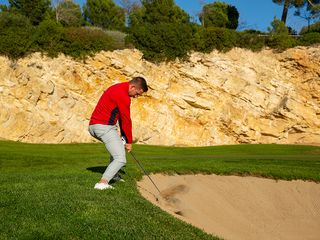Whenever your ball lands in a bunker, and no matter how good you are at playing bunker shots, your chances of getting out of trouble unscathed can be a bit of a lottery. Often, the difficulty of the shot is determined by a few key factors including your lie, the location of the ball and the height of the dreaded lip.
The walk towards the sand can be daunting, but as you contemplate your escape from the trap there are some key tips you could be focusing on.
In this video and article, Golf Monthly Top 50 Coach Alex Elliott takes us through what he classifies as the ‘three hardest bunker shots you could face’, and explains using his expert knowledge how to play these tricky shots…
Alex Elliott
Alex spent three years caddying on the European Tour before taking his PGA qualifications. Since then he has created a thriving social media platform on Instagram and YouTube, where he offers a whole host of tips and advice to help viewers shoot lower scores.
1. Top Of The Bunker (Feet Outside The Sand)
So, you have arrived at your ball and realised it’s sitting right at the top – ultimately looking pretty perilous. The ball is therefore going to be below your feet, so you need to make one key compensation.
Bring your hands up the grip, so that your pinky finger is almost hanging off the end of the butt, which means you can save your knees from having to make a really exaggerated bend to get the club down to the ball.
Take a nice wide stance, sit down into the shot and try to avoid having the face too open. Concentrate on digging the club into the sand and fully commit to the shot. As you can see in the video, I managed to get the ball out first time, and I advanced it towards the green, so use these bunker tips to prevent you wasting shots in the sand.

Grip high up the club, near the butt, to save your knees
(Image credit: Howard Boylan)
2. Back Of The Bunker
I’m going to be honest… I hate this one. You practically have to do the splits in order to play the shot, so flexibility and mobility is going to be important. Being so close to the back edge of the bunker means you have practically no room to get your club up and back to the ball in a natural movement, and all your weight tends to be on your lead side.
You can start to counter-act this by…
..
Click Here to Read the Full Original Article at Golf Monthly…